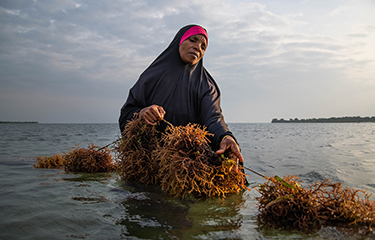A number of Africa’s seaweed producers are among those expected to post substantial seaweed market growth as global pressure mounts on governments to increase seafood production, reduce global warming, and restore overexploited marine fisheries to sustainable levels.
Growing demand for the vitamins and minerals found in seaweed, primarily for use in the manufacture of food, healthcare, and personal care products, is a key driver in the expansion of the commercial seaweed market, according to a 360 Market Research report.
“The market for commercial seaweed is witnessing substantial growth prospective,” the report says.
Although the report highlights the market trends in South Africa, Nigeria, and Egypt, Africa’s seaweed production is largely concentrated in Tanzania, Morocco, and Madagascar, according to the Food and Agriculture Organization (FAO). Tanzania and Madagascar are among the top aquaculture producers on the continent of the Kappaphycus/Eucheuma seaweed species, despite disease having depressed production in Tanzania – specifically on the island of Zanzibar – forcing farmers to resort to the lower-valued Eucheuma denticulatum, according to the FAO.
Even taking into account the top producers, Africa’s share of global seaweed production remains less than 1 percent. However, Africa’s seaweed production levels are expected to increase after The Nature Conservancy (TNC) – in partnership with local suppliers, government partners, universities, and U.S. company Cargill – launched a new seaweed farming “community empowerment and environmental training program for seaweed farmers” through its new sustainability initiative the “Red Seaweed Promise” in Tanzania’s islands of Zanzibar and Pemba.
Some of the specific areas the partnership is focusing on include “trainings in better environmental management practices, smart seaweed farm siting, and improved maintenance and farm design.”
The Nature Conservancy said Tanzania is where a large share of the seaweed produced is “dried, and sold for use as carrageenan or agar thickening agents that are used in food products, such as ice cream and cosmetics,” has huge potential to produce tropical seaweeds that could address demand of other “other key societal needs - including sustainable animal feeds, biofuels, pharmaceuticals, and nutraceuticals.”
However, Africa’s seaweed producers continue to face market growth hurdles including the inadequate understanding and awareness on the use of seaweed in human nutrition, the FAO said. For seaweed to become a key nutritional component especially in low producing regions such as Africa, FAO recommends a concerted effort by “stakeholders and experts in policy, business, and scientific communities to make seaweeds acceptable, available, and affordable.”
Photo courtesy of The Nature Conservancy







